From Painting to Digital 3D Art
This week I have a video that is made for all who love art and love creating art. It’s about my artistic journey from painting to digital 3D art. My new digital creations move and change color on screen and in virtual reality.
3D Art – Watch the Video!
I am currently making digital artwork in a three-dimensional world. I have received a grant for it from The Finnish Cultural Foundation. The project will continue until September 2024, but it has progressed to the extent that it is good to gather thoughts and show some results on a video.
The main programs I mentioned in the video are Nomad Sculpt, Blender, and Unity. My virtual glasses are Meta Quest 3.
The artwork is not finished yet. The most important thing that I need to do is the interaction with the viewer. I will also include sounds. Fortunately, the project still has five months left. The project is part-time, but on the other hand, breaks are good, because the ideas have time to grow.
Traditional 2D Meets Digital 3D
I understand that I am only at the beginning of everything that technologies make possible and where my artistic thinking can go. It’s exciting. For a long time, I have envied how the students of my painting and drawing courses have great enthusiasm to learn new things. Now I have this situation with digital art.
I am grateful to have been born in an era where all this is possible. With digital art, we have something Rubens and Kandinsky would envy. It would be wonderful to show them all this, even if it would be only just this video. I think a certain da Vinci would like to join Rubens and Kandinsky! There have always been artists who have wanted to see into the future and go on a journey to an unknown land. I think this attitude doesn’t break the tradition but keeps it alive.
What do you think?
Belonging Somewhere as an Artist
This week, I share my word for 2024 and thoughts about the good and bad in the sense of belonging. I also have a new finished painting!
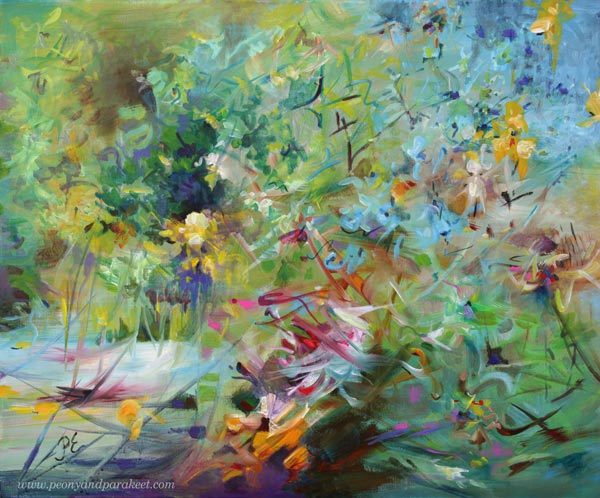
See more pics at the Taiko art store!
I haven’t used acrylic paints on a canvas for a long time. But now I wanted to paint faster and not wait for the layers to dry.
Painting Freely
This painting took me a couple of long evenings and I deliberately left it abstract, because the subject of the painting is not about the flowers, but about the power rising from the ground.
Here’s how the painting started: loose strokes and juicy colors.

It’s easy to fall in love with colors, but when you want depth, you also need muddy colors: browns and greys.
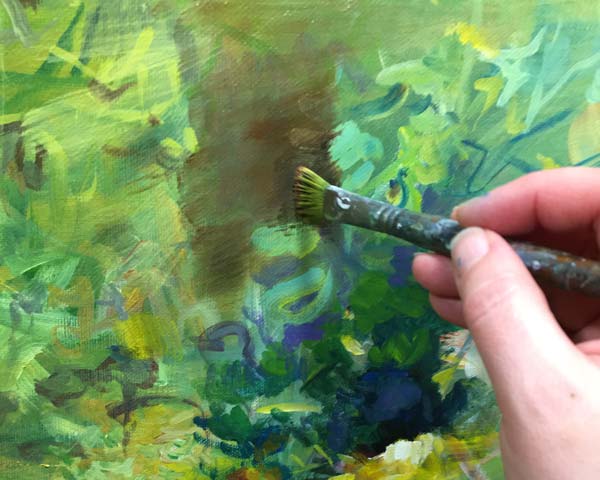
I like to use several different brushes in one painting, and my favorite brushes are very thin.

The title “Muutosvoima – Driving Force” sums up what I want to tell with this painting. Muutosvoima could also be translated as “power of change.”

I believe that the best power of change is not the hype created by others, but the inner enthusiasm that has a grounded tone. Because isn’t it so that flowers only bloom when the earth warms up? Sunlight alone is not enough.
Belonging Somewhere – The Good and The Bad
I’ve been thinking about togetherness lately. It’s a wonderful feeling. For example, last week when many people commented on my post, I felt happy that this blog brings us together. One of the best things that has come with the internet is that you can be pretty weird and still find like-minded people.
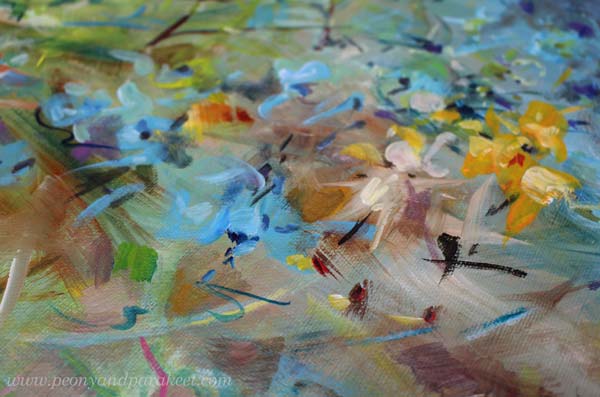
However, the sense of belonging has its danger. Art is about walking your own path. Encounters are important, but you also need to go in the other direction to create something unique. As a teacher, I have often thought about how I could better guide people in their own direction.

Art is like a pot that you have to break first and then put together again. The pot can be broken in many ways and at best, you find your own way to put it together. You need a driving force to break the pot and then persistence to rebuild it.
Finding Your Places in the Art World
In my career as an artist, I have often wanted to be like someone else. I have envied popular artists and then later realized that I wouldn’t want to create the kind of art that they do. I realized that I would like to be popular in creating something else and somewhere else.

With experience, the art world opens up. Instead of one hall, you begin to see numerous smaller rooms. What is popular in one room can be overlooked in another. Being an artist requires a lot of self-esteem and the power to move from one room to another.

When you find one room that feels like your own, the sense of belonging is at its greatest. However, it’s better to move between several rooms and find many groups. At best, the artist acts as a bridge between different things.
My Word of the Year – Do You Have One?
My word for 2024 is Integrate. This year I have allowed myself to do more diverse things, but on the other hand, I have tied all the pieces together so that one benefits the other.
Have you chosen a word for this year? How has it been realized?
Artist’s Life – Starting New Media Art
This week, I share my latest new media art and thoughts about my career as an artist. This is a sequel to the blog post called Beginner’s Video Art that was published last month.
Unstill Still Life – Video Art
The video above is my latest artwork “Unstill Still Life.” I have done this largely by programming. I have developed generative algorithms that create and alter shapes. I have designed the individual shapes with a 3D modeling program called Blender. The models and the code are put together with the Unity Engine which is a software environment for developing games.
Inspiration from an Old Painting
With the artwork, I participated in the Finnish National Gallery’s Web3 community Alusta challenge called “Nature and Nourishment.” The Finnish National Gallery has many copyright-free images and the organization encourages artists to use them for creating new media art.
I have taken inspiration for the colors and surfaces, as well as the concept itself, from Fanny Churberg’s 1876 painting “Still Life with Vegetables and Fish.”

I love old paintings, so this challenge was made for me. It’s so interesting to examine the brush strokes and think about the 3-dimensional shapes that they are related to. And I have so much to learn in making generative art, that I need small challenges to keep heading forward.
I Will Continue Painting, But …
I am still going to continue painting traditionally but I also want to start a career in new media art. I want to bring back my skills in programming from the years when I was a software engineer and use those for creating art. I also have a degree in Industrial Design that helps a lot with 3D modeling. The grant that I received from The Finnish Cultural Foundation has enabled me to develop my style in new media.
But all this is not only exciting but hard too. Do you know that feeling that comes when you have to start life over again? There is enthusiasm in the air, but also some “oh no”.
Building a CV
For a full-time artist, most opportunities are based on a CV.
That was not a problem when I graduated in software design in 1996. I thought: “I have plenty of time to grow my CV.” Then, when I graduated as an industrial designer in 2009, life seemed to be halfway over, but I was able to get quite a decent CV by combining some old and new projects.
When I started working as a full-time visual artist in 2014, I didn’t think about CVs at all at first.

The picture above is from 2015 when most of my art was in art journal pages.
But when I moved forward in painting, the reality hit me – it was very hard to get accepted to exhibitions and organizations without a CV. Mine was practically blank at first, and it has taken a lot of time and effort to add rows to it.

The picture above is from last summer at the exhibition organized by The Albert Edelefelt Foundation. See more pics in this blog post!
New Media Art – New Career?
And just when I thought that life was almost over at the age of 55, this new media digital art came into my life and it hit me – I’m a beginner again with an empty CV. So, I need and want to participate in challenges, competitions, and exhibitions, to get accepted again. And I want to believe that I still have time to create this new kind of art, not only paintings.

Some leaves of the big plant are connected to an invisible virtual camera that moves around and sends a mirror image to them.
I learn new things about generative art every day and I am amazed that I have been given this long life to experience it. Gratitude is the overriding emotion that emerges from this new beginning. I am lucky in what I have seen in the development of information technology and what I have been able to develop and be involved in developing in the past. I want my future CV to tell the story of a girl who wanted to become an artist as a child, who fell in love with computers as a teenager, and who finally has the artistic vision and the technical tools to combine the two.
Looking Back Enables Seeing Forward
If you have been following my blog for a while, you must have noticed that my blog posts are often self-reflective like this one. Visual art-making needs self-reflection too. It’s useful to go back and see how things have changed to make future changes and take steps forward.
With the newest course Liberated Artist Revisited, I invite you to paint with me – to follow directions from Paivi many years ago, and then create more with the current Paivi. At the same time, you can ponder, how your art-making has changed and will change.

Liberated Artist Revisited is a limited edition – only available for purchase until the end of March 2024! >> Buy Now!
New Beginnings in Art-Making
Let’s think about new beginnings and give one to our art-making!

In recent months, I have felt that a new era has begun in my life. It has been surprising. I have thought that I am already too old for anything new – that the new beginnings in life have already been experienced, at least in terms of working life. But it just so happened that my work as an artist has a new beginning thanks to the grant for creating digital art.
At the same time, I have gained a new perspective on the past and my artistic development. Now, it feels that life with its changes is full of new beginnings, and art, too, is full of them! There are big beginnings and then smaller beginnings within them.
Valuing Randomness and Intuition
I developed the latest course Liberated Artist Revisited, because I wanted to relive the idea of the old course Liberated Artist. I wanted to relive that time in 2015 when a new beginning meant letting go of excessive control and surrendering to happy accidents and intuition. Because isn’t it the case that whenever a new era begins, we need faith in chance and intuition – so, the art of letting go!

At the current new beginning, I have been thinking about what I have to give up. Because, couldn’t you say that life with its changes is full of not only beginnings, but endings, and ask if the same applies to art? While making the course Liberated Artist Revisited, I listened to Paivi from 2015.
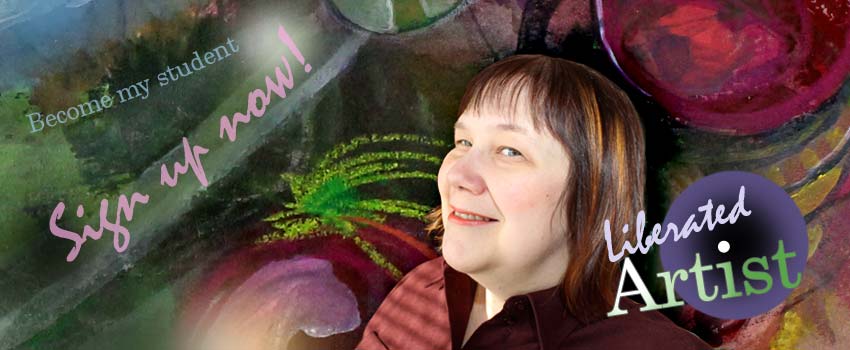
Younger Paivi was very prompt: Step A and Step B and so on. If I compare her and I, I am partly different and partly similar. I would do some things differently now but in many ways., I am still quite the same artist. The new course Liberated Artist Revisited is a dialogue between the old and the new. You could also say that I have changed as an instructor a bit. Nowadays, I want to open up your artistic thinking, not so much to exclude options.
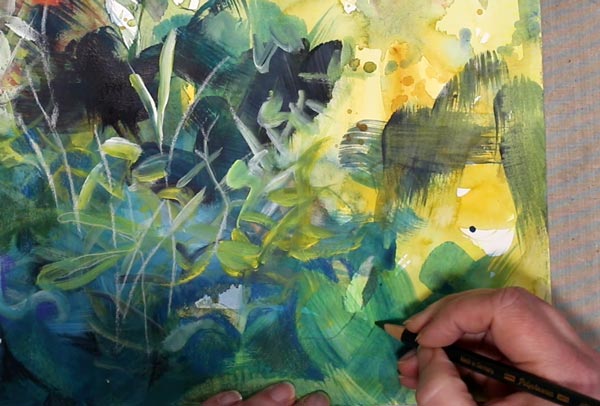
Life is so grand that everything that once had a beginning, stays in our hearts for a long time, even if it has ended. It’s the same in art. I can smile at Päivi after more than eight years, but not ironically, but warmly. “It’s wonderful to create something new with you again,” I say to young Päivi, and it’s also wonderful to invite you all to a new course again!
Liberated Artist Revisited – Buy Now!
Liberated Artist Revisited is a limited edition – only available for purchase until the end of March 2024! >> Buy Now!